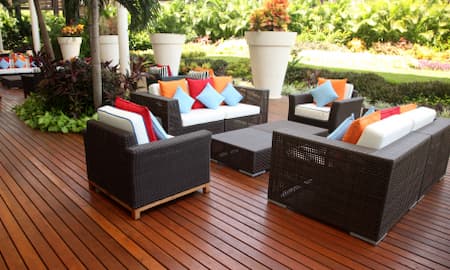
To Stain Or Not To Stain?

To stain or not to stain? That is the question asked by many homeowners as they prepare to add a deck to their property. The importance of deck staining is often stressed a lot by deck builders and home renovation experts. But does every deck need to be stained? If not, which types do, and how often? We're here to clear up some of those questions.
Composite Decks- Stain Or No?
Artificial materials such as composite board are the types of decking materials that make people pause. Composite boards are partially plastic, but they also have wooden components too. So should they be stained or not?
In the early days of composite decking, it may have been a good idea to stain them. However, the configuration of materials used in modern composite board allows for the built-in protection of the natural components, so the good news is that you don't need to stain modern composite board. In fact, modern high-performance Trek decking cannot be stained or painted, though older (pre 2014), non-capped composite decking can be if desired.
Staining Exotic Wood Decks
Where deck staining really matters is with wooden decks. These natural materials are more vulnerable to environmental stressors like solar radiation, moisture, insects, and invasive growths like algae and mold. But different types of wood need different levels of protection!
Exotic hardwoods are denser, making it hard for normal deck stains to penetrate the surface. Additionally, exotic hardwood is also naturally resilient thanks to its density and natural oil content. They also tend to be very rich in color, which many homeowners don't want to alter. Most hardwood deck owners opt for either a clear topcoat or decking oil formulated specifically for hardwood.
Staining Pine And Other Softwoods
Here's the category where deck staining is most crucial. Any good deck builder will advise you to stain and/or paint your deck if it's made from pressure-treated pine, cedar, or a similar softwood. While the chemical infused into pressure-treated wood help protect it against bugs and decay, staining can enhance its protection and also prevent cracking, fading, and sun and moisture damage!
Stains can also alter the look over your deck, allowing you to customize its appearance. There are two main types: oil-based and latex-based. Oil based stains sink into the wood and enrich its color but otherwise preserve its appearance. Latex-based stains are closer to paint, and you lose the appearance of the wood grain underneath them- but they can be good if you want a bold look!
Staying On Top Of Stains
If you're going to stain your deck, you should do so soon after it's built. Because pressure-treated wood contains residual moisture, it should be allowed to dry out for at least a few days after construction before you stain it, though some specialists advise waiting for a month if the wood is especially saturated. Hardwood decks typically should be aged for 6-8 weeks before stains or topcoats are added.
It's important to stay on top of stains too. While some materials occasionally need it more frequently, the general rule is that deck owners should have their deck staining redone every 2-3 years for even, long-lasting protection. An expert deck builder or exterior cleaning specialist can gently remove the remnants of the old coat and restain the surface.
At Decks By Chris, we love seeing our customers' investments last. Quality deck staining can help your deck look beautiful and resist wear and tear for decades to come. If you'd like to take advantage of our professional deck staining services, call us at 973-750-4117.
Give Us A Call To Start Your Custom Deck Project In Vernon & The Surrounding Areas Today